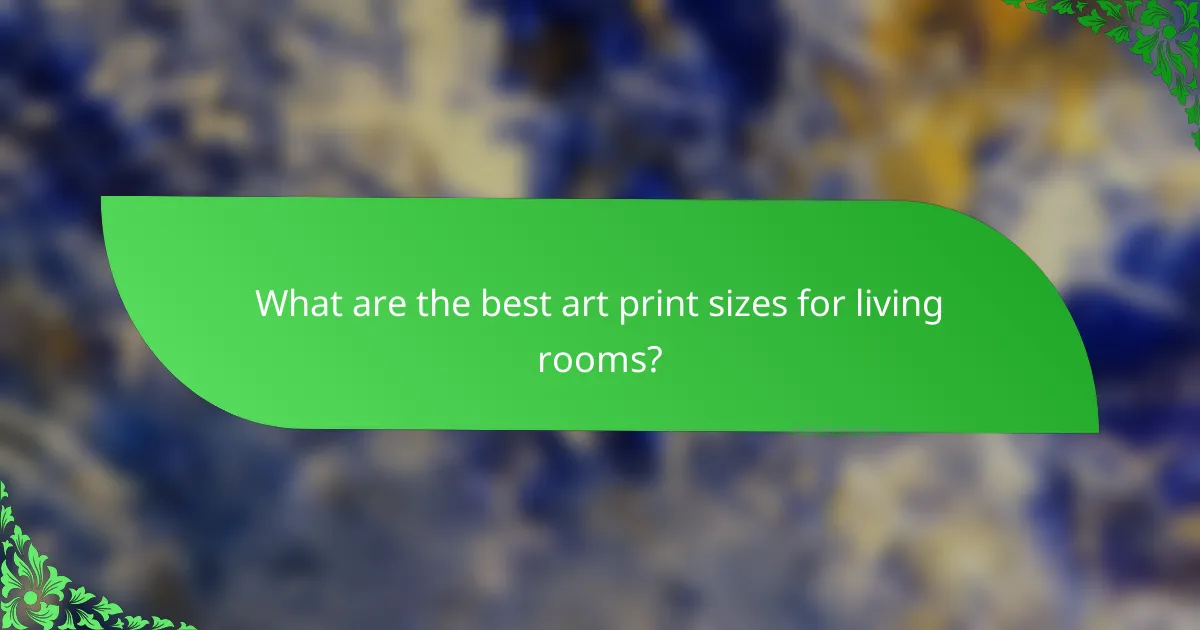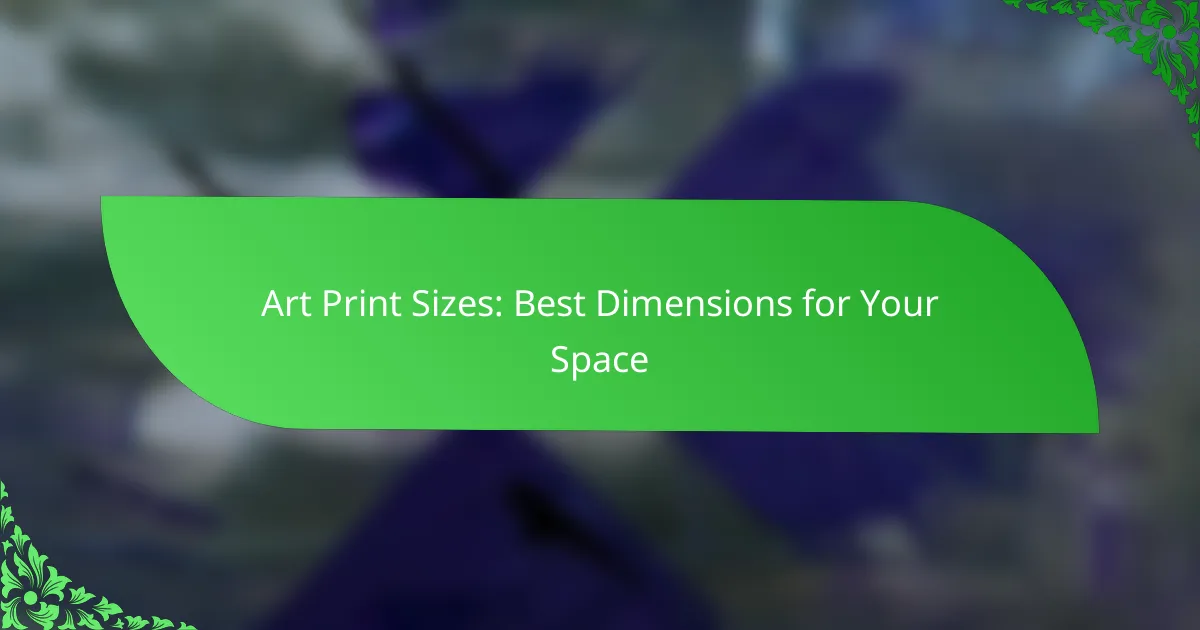When selecting art print sizes for your space, it’s essential to consider both the available wall area and the desired aesthetic impact. Larger prints can create a bold statement in expansive rooms, while smaller pieces are ideal for more intimate settings. By understanding the dimensions that best suit each environment, you can enhance the overall ambiance of your home or office.

What are the best art print sizes for living rooms?
The best art print sizes for living rooms depend on the available wall space and the desired visual impact. Generally, larger prints work well for expansive walls, while smaller prints suit cozier areas.
24×36 inches for large wall spaces
A 24×36 inch print is ideal for large wall spaces, making a bold statement in your living room. This size works well above sofas or mantels, drawing attention and serving as a focal point.
When selecting a 24×36 inch print, consider the surrounding decor to ensure it complements the overall aesthetic. Choose artwork that resonates with your style, whether it’s a vibrant landscape or an abstract piece.
16×20 inches for smaller areas
The 16×20 inch size is perfect for smaller areas, such as nooks or above side tables. This dimension allows for a more intimate feel while still providing visual interest without overwhelming the space.
When placing a 16×20 inch print, ensure it is at eye level for optimal viewing. Pair it with smaller decor items to create a balanced look that enhances the room’s charm.
Gallery wall arrangements with multiple sizes
Gallery wall arrangements can feature multiple sizes, creating a dynamic and personalized display. Mixing various dimensions, such as 8×10, 11×14, and 16×20 inches, adds depth and interest to your living room.
To achieve a cohesive look, use a unifying theme or color palette across the prints. Plan the layout on the floor before hanging to visualize the arrangement and ensure it fits well within the available wall space.

How to choose art print sizes for bedrooms?
Choosing art print sizes for bedrooms involves considering the available wall space and the visual impact you want to create. Aim for proportions that balance the room’s dimensions and complement existing furniture.
20×30 inches for above the bed
A 20×30 inch art print is an excellent choice for placement above the bed, as it draws attention and serves as a focal point. This size works well in most bedrooms, providing a substantial visual presence without overwhelming the space.
When selecting a piece of this size, consider the height of your ceiling and the width of your bed. A print that is about two-thirds the width of the bed frame typically creates a harmonious look. For example, if your bed is 60 inches wide, a 20×30 inch print will fit nicely.
12×16 inches for bedside tables
For bedside tables, a 12×16 inch art print is ideal, as it adds a personal touch without taking up too much space. This size is perfect for smaller artworks or photographs that can enhance the ambiance of your bedroom.
Position the print at eye level, ensuring it is easily visible when sitting or lying in bed. You might also consider using a small easel or frame to elevate the artwork slightly, making it a more prominent feature on the table. Avoid cluttering the bedside area; one or two well-chosen prints will suffice for a balanced look.

What are common art print sizes for offices?
Common art print sizes for offices typically include dimensions that enhance professional environments while fitting well within the available wall space. Popular sizes like 18×24 inches and 8×10 inches cater to various needs, from large statement pieces to smaller desk decorations.
18×24 inches for professional settings
The 18×24 inch size is ideal for professional settings, as it provides a substantial visual impact without overwhelming the space. This size works well for conference rooms, lobbies, or any area where you want to make a strong impression.
When selecting an 18×24 inch print, consider the surrounding decor and wall color to ensure it complements the overall aesthetic. Framing options can also enhance the presentation, with sleek frames often preferred in corporate environments.
8×10 inches for desk decor
The 8×10 inch size is perfect for desk decor, allowing for personal expression without taking up too much space. This size can easily fit on a desk, shelf, or small wall area, making it versatile for various office layouts.
When choosing an 8×10 print, think about the theme and colors that resonate with your workspace. Grouping several 8×10 prints together can create an engaging gallery effect, adding character to your desk area while keeping it organized.

How do art print sizes affect room aesthetics?
Art print sizes significantly influence the overall aesthetics of a room by affecting visual balance and creating focal points. Choosing the right dimensions can enhance the harmony of your space and draw attention to specific areas.
Proportional sizing enhances visual balance
Proportional sizing refers to selecting art prints that complement the dimensions of the wall and surrounding furniture. For instance, a large print can overwhelm a small wall, while a tiny piece may get lost on a spacious surface. Aim for a size that maintains a ratio of about 2:3 or 1:2 to the wall space for optimal balance.
Consider the height and width of your furniture when selecting art. A print should ideally be two-thirds the width of a sofa or table to create a cohesive look. This proportionality helps the artwork feel integrated into the room rather than disconnected.
Oversized prints create focal points
Oversized prints can serve as striking focal points in a room, drawing the eye and creating a dramatic effect. These pieces work best in larger spaces where they can dominate without feeling cramped. A print that measures at least 36 inches on one side can make a significant impact.
When using oversized art, ensure it is hung at eye level for maximum effect. This positioning invites viewers to engage with the piece and enhances the overall aesthetic of the room. Avoid cluttering the area around the print to maintain its prominence.

What factors influence art print size selection?
Several factors influence the selection of art print size, including the dimensions of your wall space, the layout of the room, and the style or theme of the artwork. Understanding these elements will help you choose prints that enhance your environment and create a cohesive look.
Wall dimensions and layout
When selecting art print sizes, first measure your wall dimensions to determine available space. A common guideline is to leave some empty space around the artwork, ideally around 10-20% of the wall area, to avoid a cramped appearance.
Consider the layout of the room as well. For example, large prints can serve as focal points in spacious areas, while smaller prints may work better in tighter spaces or as part of a gallery wall arrangement. Aim for balance and harmony in your design.
Art style and theme
The style and theme of your artwork significantly impact size selection. Bold, abstract pieces may benefit from larger dimensions to make a statement, while delicate or intricate works might be more effective in smaller formats that allow for closer inspection.
Additionally, consider the overall theme of your space. For instance, a minimalist decor might call for larger, simple prints, while a cozy, eclectic room could accommodate a mix of sizes and styles. Always ensure that the art complements the existing decor rather than overwhelming it.

What are the standard art print sizes available?
Standard art print sizes are commonly used dimensions that help simplify the selection process for framing and displaying artwork. These sizes are typically measured in inches and include a variety of options to fit different spaces and aesthetic preferences.
Common sizes: 8×10, 11×14, 16×20
The most popular standard sizes for art prints include 8×10, 11×14, and 16×20 inches. These dimensions are widely available and fit easily into standard frames, making them convenient choices for home decor.
For instance, an 8×10 print is ideal for small spaces or gallery walls, while a 16×20 print can serve as a striking focal point in larger rooms. When selecting a size, consider the scale of your wall and the surrounding furniture to ensure a harmonious look.
Custom sizes for unique spaces
Custom sizes allow for flexibility in art print dimensions, catering to specific wall spaces or personal preferences. This option is especially useful for non-standard wall areas, such as above furniture or in narrow hallways.
When opting for custom sizes, measure your space carefully and consider how the artwork will interact with other elements in the room. Custom prints can be more expensive, so weigh the benefits against your budget and the overall design of your space.

How to measure for art print sizes?
To measure for art print sizes, start by determining the available wall space and desired placement. Accurate measurements ensure that your art fits well within the intended area, enhancing the overall aesthetic of your space.
Use a measuring tape for accurate dimensions
Using a measuring tape is essential for obtaining precise dimensions of your wall space. Measure both the width and height of the area where you plan to hang the art, and note these measurements down. It’s advisable to measure in multiple spots to account for any irregularities in the wall.
For best results, consider measuring at least twice to confirm accuracy. If you’re planning to arrange multiple pieces, sketch a layout and measure each section accordingly to ensure a cohesive look.
Consider frame and matting thickness
When selecting art print sizes, factor in the thickness of the frame and matting. These elements can add several centimeters to the overall dimensions, impacting how the art fits into your space. A thicker frame may require more wall space than anticipated.
To avoid surprises, measure the frame and matting you intend to use and add these measurements to the dimensions of the art print. This will help you visualize how the finished piece will look in your space and ensure it complements your decor effectively.
